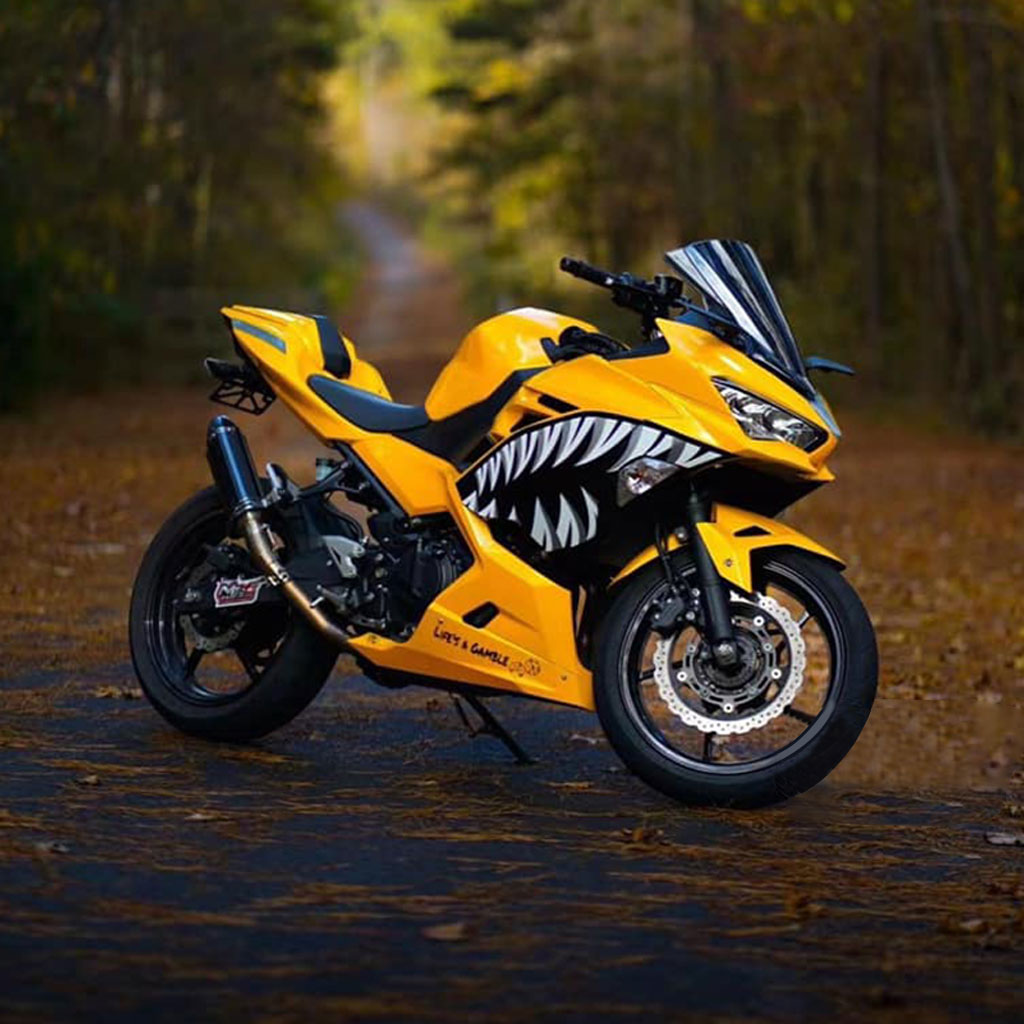Smart Riding: Top Habits to Stay Safe on Sport Bikes in Urban Traffic
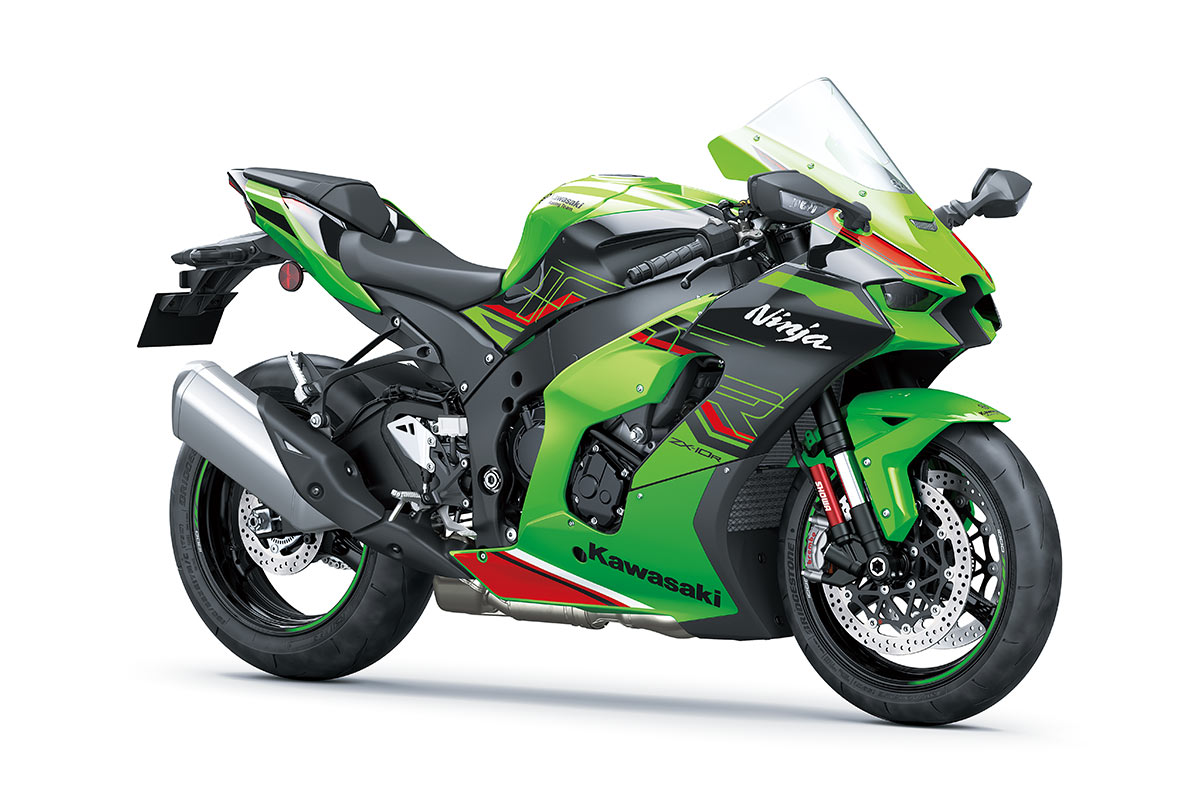
You face real dangers each time you ride your sport bike in city traffic. Most bicyclist deaths happen in cities. These often involve cars at intersections. Smart riding can help a lot. Using smart riding habits helps you stay aware. It helps you avoid distractions. It lowers your risk every time you ride.
Key Takeaways
Always obey traffic laws and wear safety gear like helmets and bright clothes to stay safe and easy to see in city traffic.
Use clear signals, pick the best lane spot, and keep a safe space to help others know what you will do and stop crashes.
Stay alert by looking for dangers, checking mirrors often, and riding carefully so you can react fast to surprises on busy city streets.
Smart Riding Basics
Follow Traffic Laws
You ride your motorcycle in busy city streets every day. You face heavy traffic, tricky intersections, and lots of people walking or biking. You need to obey the traffic rules at all times. When you follow the rules of the road, you help keep yourself and others safe. You lower your risk of accidents and avoid fines or tickets.
Did you know? Cyclists and drivers both follow traffic laws most of the time, but even small mistakes can lead to big problems. Studies show that riders who take safety courses and obey the traffic rules have fewer crashes. You also help traffic flow better and make the city safer for everyone.
Here are some tips to help you follow the rules:
Stop at all red lights and stop signs.
Watch your speed and stay within the limit.
Yield to pedestrians and other vehicles when needed.
Use your signals before turning or changing lanes.
Wear Protective Gear
You need to wear the right motorcycle gear every time you ride. Your gear protects you from injury and helps you stay visible. Always wear a helmet. A good helmet can save your life in a crash. Choose bright clothing and reflective strips to help drivers see you.
Wear gloves, a sturdy jacket, and pants made for motorcycle riding.
Use boots that cover your ankles.
Wear protective eyewear to shield your eyes from dust and debris.
Your gear does more than protect you. It gives you confidence and helps you focus on the road. When you wear a helmet and the right gear, you show that you care about safety. Smart riding starts with smart choices.
Visibility & Positioning
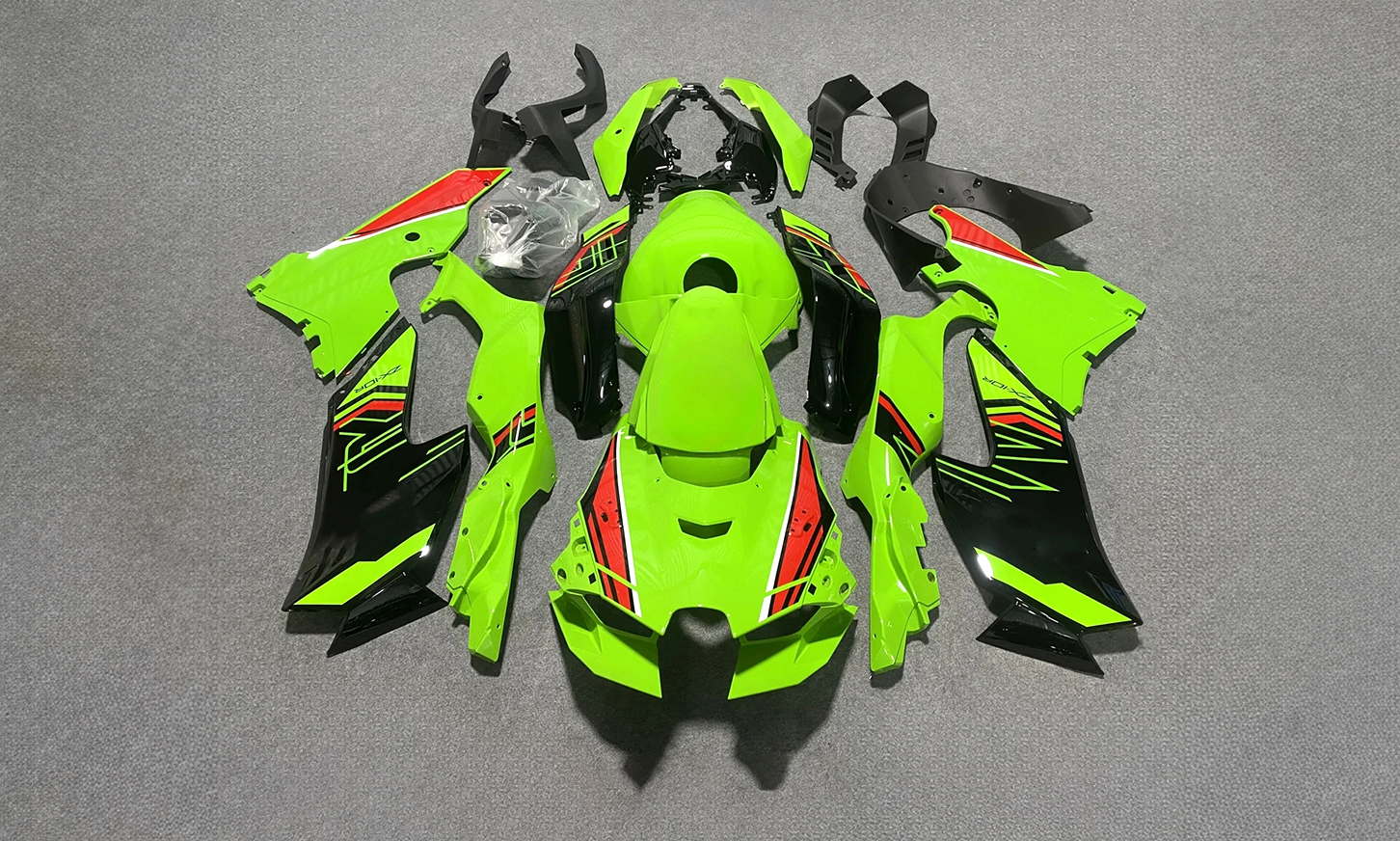
Be Seen
You want drivers to notice you every time you ride your motorcycle in the city. Many crashes happen because drivers do not see motorcycles soon enough. You can take simple steps to boost your visibility and stay safe.
Wear bright or fluorescent clothing. Contrasting colors on your jacket, helmet, and even your backpack help you stand out. Studies show that riders with checkerboard jackets and yellow stripes get noticed faster than those in grey.
Use your motorcycle’s headlights during the day. This small step can cut your crash risk by about 7%.
Pick a white or light-colored helmet. Riders with these helmets have up to an 18% lower crash risk.
Add reflective strips to your gear and your motorcycle. These strips shine when headlights hit them at night.
Tip: Distribute bright colors across your body and your motorcycle. This makes you easier to spot from all angles.
Here’s a quick look at how different choices help you be visible and reduce accident risk:
Visibility Factor | Effect on Accident Risk |
|---|---|
Reflective/fluorescent clothing | Up to 33% fewer serious injuries or deaths |
White/light-colored helmet | Up to 18% lower crash risk |
Daytime headlight use | About 7% lower crash risk |
Lane Position
You control your safety by choosing the best spot in your lane. Your lane position changes how well drivers see you and how much space you have to react.
Stay out of blind spots. Ride where drivers can see you in their mirrors.
In heavy traffic, the center of the lane often gives you the best view and keeps you away from sudden lane changes.
On wet roads, avoid the center of the lane. Oil and water collect there and make it slippery.
Adjust your lane position to keep a safe distance from cars, trucks, and road hazards.
Motorcycle safety experts say you should change your lane position based on traffic, weather, and road conditions. When you ride faster, move away from the edge of the road to give yourself more space. This helps you avoid obstacles and gives you time to react. Wide lanes can tempt riders to speed, so stay alert and pick your spot carefully.
Remember: You can be visible and safe by wearing the right gear and picking the best lane position. Make these habits part of every ride.
Safe Riding Habits
Predictable Riding
You want drivers, cyclists, and pedestrians to know what you will do next. When you ride your motorcycle in the city, you need to be predictable. This means you avoid sudden moves and always act in ways others expect. If you stop or turn without warning, you confuse people around you. That’s when accidents happen.
Smart riding means you keep your actions steady and clear. You ride in a straight line, avoid weaving between cars, and never make last-minute lane changes. You slow down early before stopping. You signal before you turn. You check your mirrors often. These habits help everyone on the road understand your next move.
Tip: If you want to be predictable, act like you are driving a car. Stay in your lane, follow the flow of traffic, and make your intentions obvious.
Research shows that safe riding habits, like being predictable, really work. In Bandung City, Indonesia, a study found that riders who prepare well, wear the right gear, and follow safe habits have fewer accidents and traffic violations. The study also found that just thinking about safety is not enough. You need to practice these habits every time you ride. Good road conditions and healthy riders also help lower accident rates. Schools and cities that teach smart riding see fewer crashes.
Let’s look at how predictable riding connects to safer streets:
Factor | How It Helps You Stay Safe |
|---|---|
Riding in a straight line | Drivers can judge your path easily |
Early signaling | Others know your next move |
Avoiding sudden lane changes | Reduces confusion and surprise |
Keeping a steady speed | Makes you easier to track in traffic |
Statistical studies from cities like Barcelona and Melbourne show that when cities build better bike lanes and improve roads, people ride more and ride safer. These changes make it easier for you to be predictable and for others to see you. Social support and good habits also help you stay safe.
Use Signals
You need to use your signals every time you ride your motorcycle. Turn signals are not just for cars. They tell everyone what you plan to do. When you use your signals, you help drivers, cyclists, and walkers understand your next move. This lowers your risk of a crash.
Always use your turn signal before you turn or change lanes.
Turn off your signal after you finish your move.
Use hand signals if your lights are not working.
Make eye contact with drivers at intersections when possible.
Smart riding includes using signals in every situation. Even if you think no one is watching, use your signals. Sometimes, a driver or cyclist is just out of your view. Your signal can prevent a close call.
Note: Using signals is a simple habit, but it can save your life. It shows you care about your safety and the safety of others.
When you combine signaling with other safe riding habits, you become a model rider. You help make city streets safer for everyone. Remember, smart riding is not just about skill. It is about making good choices every time you get on your motorcycle. If you want to be predictable, use your signals and ride with care.
Awareness & Scanning
Scan for Hazards
You need to keep your eyes and ears open every time you ride in the city. Many accidents happen because riders or drivers do not notice what is around them. If you listen to music or use your phone, you miss important sounds and sights. Staying alert helps you spot trouble before it happens.
A review of road safety research shows that vision and hearing play a huge role in how well you notice danger. Distractions like headphones or texting make it harder to react in time. When you stay observant and visible, you give yourself the best chance to avoid a crash.
Tip: Look ahead, to the sides, and check for anything that moves. Watch for cars turning, people crossing, and doors opening.
Take a look at these numbers. They show why scanning for hazards matters so much in city traffic:
Statistic Description | Value | Context |
|---|---|---|
Visual scanning failures during turns | 25% | Drivers missed areas where bikes or people could appear |
Cyclist collisions at urban intersections | 51% | Vancouver, 2007-2012 |
Cyclist injuries at intersections | 33% | Vancouver, same period |
Driver failure to look right when merging | 89% | Missed cyclists on the right side |
These facts prove that missing just one check can lead to serious accidents.
Check Mirrors
You should check your mirrors often. This habit helps you know what is happening in the traffic around you. Many riders forget to look behind them, but danger can come from any direction. Use your mirrors before you change lanes, slow down, or stop.
Good riders scan their mirrors every few seconds. This keeps you aware of cars, trucks, or other bikes that might get too close. If you see a car speeding up, you can react early. If you spot a driver who looks distracted, you can give them more space.
Remember: Checking your mirrors is just as important as looking ahead. It helps you spot risks and stay safe in busy city streets.
Speed & Space
Maintain Distance
You need to keep a safe distance from other vehicles when you ride in the city. This space gives you time to react if something unexpected happens. When you follow too closely, you have less time to stop or swerve. You might not see hazards until it’s too late.
Simulation studies show that when drivers and riders manage their spacing well, traffic flows better. In busy cities, keeping the right distance can cut travel time by up to 40% and boost traffic movement by 35%. Researchers also found that the space between vehicles links directly to how fast you and others move. If you keep enough space, you lower your risk of a crash and help everyone move safely.
Tip: Try to keep at least a two-second gap between you and the vehicle ahead. In wet or busy conditions, make it even longer.
Control Speed
Speed plays a huge role in your safety. Even a small drop in speed can make a big difference. For example, lowering your speed by just 1 mph can cut traffic deaths by 6%. Slower speeds help you see more, react faster, and stop sooner. Pedestrians have a much better chance of surviving if you ride slower—about 90% at 30 km/h, but less than 20% at 50 km/h.
Speeding causes over a million deaths worldwide each year.
Lower speeds reduce tunnel vision and improve reaction time.
Shorter stopping distances mean fewer severe crashes.
Safer speed limits can even reduce traffic jams and make streets more pleasant.
Research in Florida shows that speed control is key to preventing sport bike accidents in cities. When you ride at a safe speed, you protect yourself and everyone around you.
Urban Hazards
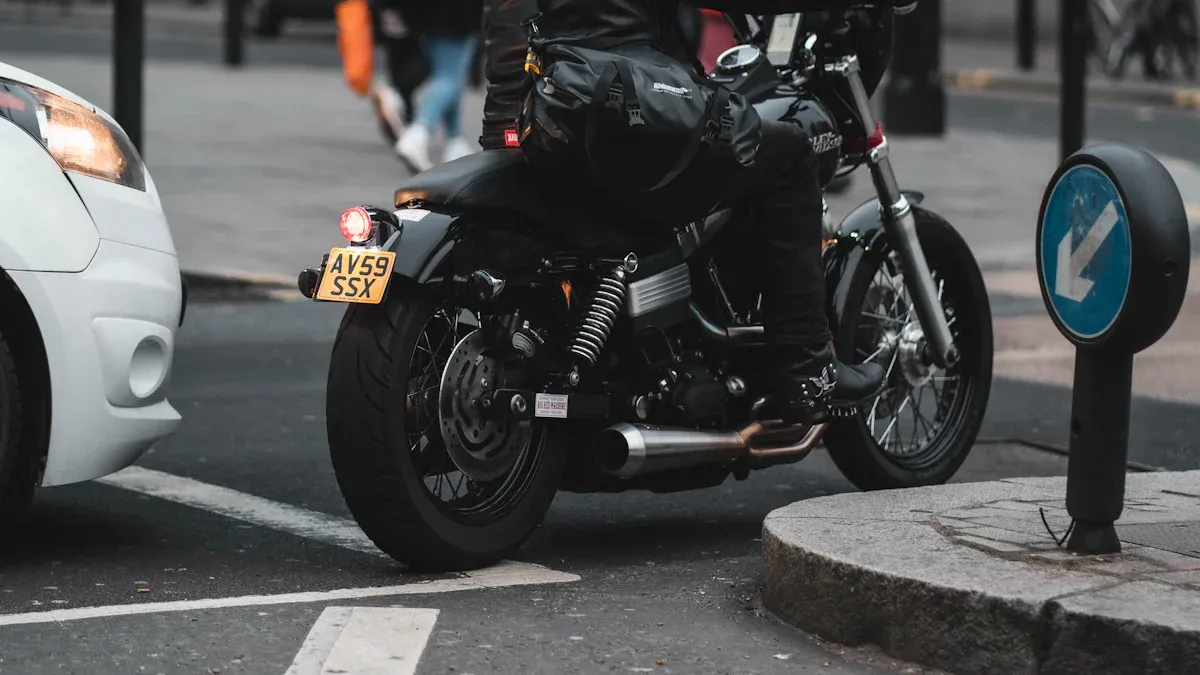
Intersections
Intersections are very risky for sport bike riders. Many drivers do not notice motorcycles when turning or crossing. Left-turn crashes happen a lot because drivers miss seeing you. In cities, intersections are busy and confusing. Cars, bikes, and people all move at once. You should slow down and watch for sudden moves.
Check out this table. It shows why intersections need your attention:
Statistic Category | Details |
|---|---|
Urban Fatality Proportion | |
Major Contributing Factors | 37% speeding, 33% alcohol, 7% distraction |
Location of Fatalities | 64% in urban areas; 56% on major roads |
You can be safer by making eye contact with drivers. Use your signals and never think others see you. City planners say better crosswalks, new signals, and roundabouts help lower crashes. When you ride through intersections, stay alert and expect surprises.
Road Conditions
City roads can change quickly. You might find potholes, loose gravel, or faded lines. These things make it hard to control your bike. Potholes can make you swerve or lose balance. Uneven pavement and debris can make your tires slip, especially in traffic.
Here are some road hazards to watch for:
Potholes and cracks
Loose gravel or sand
Faded or missing road signs
Debris from construction
Flooded or icy spots
Poor lighting at night
Bad road conditions cause many crashes. About one-third of motorcycle accidents involve bad roads. You do not have a car’s protection, so even small bumps can be serious. Always look ahead and slow down if you see trouble. If you spot a hazard, signal early and give yourself more space.
Motorcycle Safety Tips
Defensive Riding
You can stay safer if you ride defensively every time. Defensive riding means you are ready for surprises. You look for cars that might turn without using signals. Some drivers do not see motorcycles. You keep space between you and other vehicles. Never think everyone will follow the rules.
Check out these common motorcycle crash types:
Statistic Category | Data / Percentage | Why It Matters for Safety |
|---|---|---|
Broadside crashes | 27.0% | Watch out at intersections |
Overturned crashes | 18.9% | Practice good control |
Hit object crashes | 16.3% | Look for things in the road |
Rear end crashes | 15.4% | Keep a safe distance |
Sideswipe crashes | 11.7% | Stay in your lane |
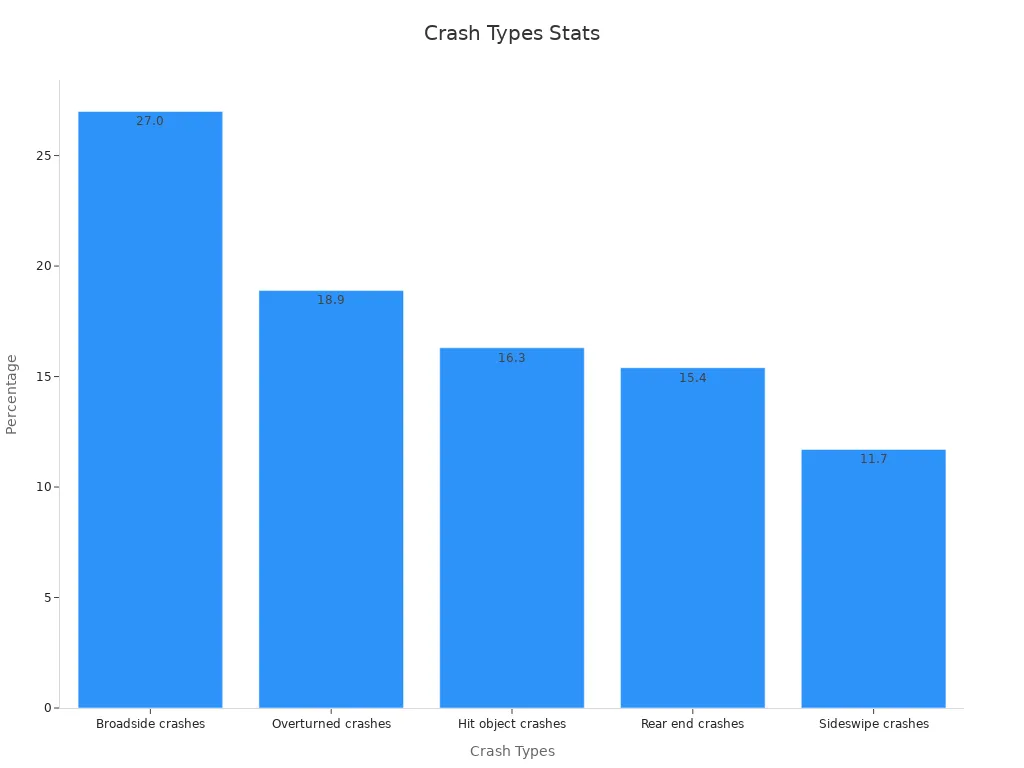
You can lower your chance of a crash by doing these things: Scan the road ahead and to the sides. Check your mirrors often. Wear bright gear and use your headlights so others see you. Do not ride if you feel tired or distracted.
Many riders forget that defensive riding is a skill you can get better at. If you take a motorcycle safety class, you learn how to spot danger early. You also learn how to react the right way. These classes help you feel more confident and improve your skills.
Tip: About 34% of riders in deadly crashes did not have a license. Always get your license and keep your training up to date.
Emergency Maneuvers
Sometimes you must act fast to avoid a crash. Emergency moves like quick braking or swerving can help you. Most riders hit the brakes when they see a car turn or a hazard pop up. Your reaction time is important. Studies show riders often brake within one second, but stopping still takes space.
Here are some ways to practice emergency skills: Find a safe, empty lot to practice hard braking and quick swerves. Learn how your motorcycle feels when you brake hard. Take a motorcycle safety class to master these moves.
Even skilled riders cannot avoid every crash. You can do better by staying alert and practicing often. Research from Vietnam shows that better hazard training helps riders make safer choices. When you know what to do, you stay calm and act fast.
Note: The best motorcycle safety tips always include more training. You can never practice too much.
Stay Calm & Ride Smart
Know Your Limits
You need to know your own limits when you ride in the city. If you push yourself too far, you put yourself and others at risk. Riding tired, distracted, or after drinking can make you react slower and make poor choices. Even if you feel confident, remember that city traffic can change fast.
Intoxication and fatigue slow down your reaction time and make it harder to judge what’s happening around you.
Inexperience, like having less than three years of riding, links to more crashes in busy streets.
Speeding and risky choices raise your chances of getting into an accident.
Not following the rules or skipping safety training makes riding more dangerous.
When you know your physical and mental limits, you make safer decisions.
Training and learning the rules help you stay sharp and ready for anything.
Tip: Always check in with yourself before you ride. If you feel tired, upset, or unsure, it’s okay to wait or take a break.
Avoid Risky Moves
You might feel tempted to weave through traffic or speed up to beat a light, but these risky moves can lead to trouble. Studies show that riders who avoid sudden or dangerous maneuvers have much lower crash rates. High-risk riders, who often skip braking or react too late, crash almost four times more than careful riders. People who take risks, like driving under the influence, have accident rates more than double those who ride safely. If you stick to smart, steady habits, you keep yourself and others safe. Calm, smart riding always wins in city traffic.
You help make city streets safer when you ride smart and pay attention. Look at these facts:
Statistic Description | Statistic Value | Implication for Urban Traffic Safety |
|---|---|---|
Pedestrian fatalities in areas without sidewalks (2021) | Shows we need better sidewalks for people walking | |
Child pedestrian accidents due to darting into traffic | Almost 50% | Means kids are at risk when they run into the street |
Remember these habits every time you ride:
Always wear your helmet and gear to stay safe.
Use your signals and watch out for dangers.
Ride defensively and be ready for surprises.
Good safety habits work best with learning, rules, and help from others. You help everyone by riding smart. Keep learning and always put safety first when you ride! 🚦
FAQ
How often should you inspect your bike before riding in the city?
You should inspect your bike before every ride. Check the brakes, tires, lights, and mirrors. A quick pre-ride inspection helps you spot problems early.
What is a pre-ride inspection, and why does it matter?
A pre-ride inspection means checking your motorcycle for safety. You look for loose parts, low tire pressure, or leaks. This habit keeps you safer on busy streets.
Can you skip safety gear for short city rides?
No, you should always wear your helmet and gear. Even short rides can be risky. Safety gear protects you from injury if something goes wrong.
See Also
Tips For Ensuring Safety During Your Initial Motorcycle Journey
Best Safety Advice For Motorcyclists Using Fairing Equipment
Frequent Motorcycle Crash Hazards And Ways To Prevent Them
